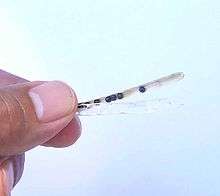Shattering (agriculture)
In agriculture, shattering is the dispersal of a crop's seeds upon their becoming ripe. From an agricultural perspective this is generally an undesirable process, and in the history of crop domestication several important advances have involved a mutation in a crop plant that reduced shattering — instead of the seeds being dispersed as soon as they were ripe, the mutant plants retained the seeds for longer, which made harvesting much more effective. Non-shattering phenotype is one of the prerequisites for plant breeding especially when introgressing valuable traits from wild varieties of domesticated crops.[1]


A particularly important mutation that was selected very early in the history of agriculture removed the "brittle rachis" problem from wheat.[2] A ripe head ("ear") of wild-type wheat is easily shattered into dispersal units when touched, or blown by the wind, because during ripening a series of abscission layers forms that divides the rachis into short segments, each attached to a single spikelet (which contains 2–3 grains along with chaff).
A different class of shattering mechanisms involves dehiscence of the mature fruit, which releases the seeds.
Current research priorities to understand the genetics of shattering include the following crops:
Sesame and canola are harvested before the seed is fully mature, so that the pods do not split and drop the seeds.[6][7]
References
- Tang, H. (2013). "Seed shattering in a wild sorghum is conferred by a locus unrelated to domestication". PNAS. 110 (39): 15824–15829. doi:10.1073/pnas.1305213110.
- Dorian Q. Fuller & Robin Allaby (2009). "Seed Dispersal and Crop Domestications: Shattering, Germination and Seasonality in Evolution under Cultivation". Fruit Development and Seed Dispersal. Annual Plant Reviews. 38. pp. 238–295. doi:10.1002/9781444314557.ch7. ISBN 9781444314557.
- Kandemir, N.; Kudrna, D.A.; Ullrich, S.E.; Kleinhofs, A. (2000). "Molecular marker assisted genetic analysis of head shattering in six-rowed barley". Theoretical and Applied Genetics. 101 (1): 203–210. doi:10.1007/s001220051470.
- Ivan N. FESENKO 2006. Non-shattering accessions of Fagopyrum tataricum Gaertn. carry recessive alleles at two loci affecting development of functional abscission layer. Fagopyrum 23: 7-10
- Brenner, D.M. 2002. Non-shattering grain amaranth populations. p. 104–106. In: J. Janick and A. Whipkey (eds.), Trends in new crops and new uses. ASHS Press, Alexandria, VA.
- Moazzami, A.; Kamal-Eldin, A. (2006), "Sesame seed is a rich source of dietary lignans", Journal of the American Oil Chemists' Society, 83 (8): 719–723, doi:10.1007/s11746-006-5029-7
- Duane R. Berglund; Kent McKay & Janet Knodel (2007), Canola Production, NDSU Extension Service, North Dakota State University, retrieved 9 November 2015

